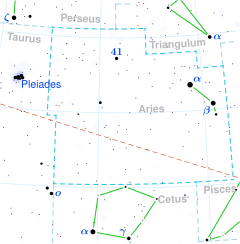Lambda Arietis (λ Ari, λ Arietis) is the Bayer designation for a double star in the northern constellation of Aries. Based upon an annual parallax shift of 25.32 arcseconds, this system is approximately 129 light-years (40 parsecs) distant from Earth. The pair have a combined apparent visual magnitude of 4.79,[2] which is bright enough to be viewed with the naked eye. Because the yellow secondary is nearly three magnitudes fainter than the white primary, they are a challenge to split with quality 7× binoculars and are readily resolvable at 10×.[8]
| Observation data Epoch J2000 Equinox J2000 | |
|---|---|
| Constellation | Aries |
| Right ascension | 01h 57m 55.71647s[1] |
| Declination | +23° 35′ 45.8295″[1] |
| Apparent magnitude (V) | 4.79[2] (4.95/7.75)[3] |
| Characteristics | |
| Spectral type | F0 V + G1 V[3] |
| U−B color index | +0.09[2] |
| B−V color index | +0.28[2] |
| R−I color index | 0.16 |
| Astrometry | |
| Radial velocity (Rv) | -1.4[4] km/s |
| Proper motion (μ) | RA: -92.55[1] mas/yr Dec.: -13.25[1] mas/yr |
| Parallax (π) | 25.32 ± 0.30 mas[1] |
| Distance | 129 ± 2 ly (39.5 ± 0.5 pc) |
| Details | |
| λ Ari A | |
| Surface gravity (log g) | 3.88[5] cgs |
| Temperature | 7,177[5] K |
| Metallicity [Fe/H] | +0.01[5] dex |
| Rotational velocity (v sin i) | 107[6] km/s |
| λ Ari B | |
| Surface gravity (log g) | 3.88[5] cgs |
| Temperature | 5,929[5] K |
| Metallicity [Fe/H] | –0.03[5] dex |
| Other designations | |
| Database references | |
| SIMBAD | data |
The brighter component is an F-type main sequence star with a visual magnitude of 4.95 and a stellar classification of F0 V.[3] At an angular separation of 37.4 arcseconds is fainter, magnitude 7.75 companion. This is a G-type main sequence star with a classification of G1 V.[3]
References
edit- ^ a b c d e van Leeuwen, F. (November 2007), "Validation of the new Hipparcos reduction", Astronomy and Astrophysics, 474 (2): 653–664, arXiv:0708.1752, Bibcode:2007A&A...474..653V, doi:10.1051/0004-6361:20078357, S2CID 18759600.
- ^ a b c d Johnson, H. L.; et al. (1966), "UBVRIJKL photometry of the bright stars", Communications of the Lunar and Planetary Laboratory, 4 (99): 99, Bibcode:1966CoLPL...4...99J.
- ^ a b c d Eggleton, P. P.; Tokovinin, A. A. (September 2008), "A catalogue of multiplicity among bright stellar systems", Monthly Notices of the Royal Astronomical Society, 389 (2): 869–879, arXiv:0806.2878, Bibcode:2008MNRAS.389..869E, doi:10.1111/j.1365-2966.2008.13596.x, S2CID 14878976.
- ^ Wilson, Ralph Elmer (1953), "General Catalogue of Stellar Radial Velocities", Carnegie Institute Washington D.C. Publication, Washington: Carnegie Institution of Washington, Bibcode:1953GCRV..C......0W.
- ^ a b c d e f Soubiran, C.; Le Campion, J.-F.; Cayrel de Strobel, G.; Caillo, A. (June 2010), "The PASTEL catalogue of stellar parameters", Astronomy and Astrophysics, 515: A111, arXiv:1004.1069, Bibcode:2010A&A...515A.111S, doi:10.1051/0004-6361/201014247, S2CID 118362423.
- ^ Royer, F.; Zorec, J.; Gómez, A. E. (February 2007), "Rotational velocities of A-type stars. III. Velocity distributions", Astronomy and Astrophysics, 463 (2): 671–682, arXiv:astro-ph/0610785, Bibcode:2007A&A...463..671R, doi:10.1051/0004-6361:20065224, S2CID 18475298.
- ^ "lam Ari". SIMBAD. Centre de données astronomiques de Strasbourg. Retrieved 2012-08-07.
{{cite web}}: CS1 maint: postscript (link) - ^ Harrington, Philip S. (2010), Cosmic Challenge: The Ultimate Observing List for Amateurs, Cambridge University Press, p. 113, ISBN 978-0521899369
